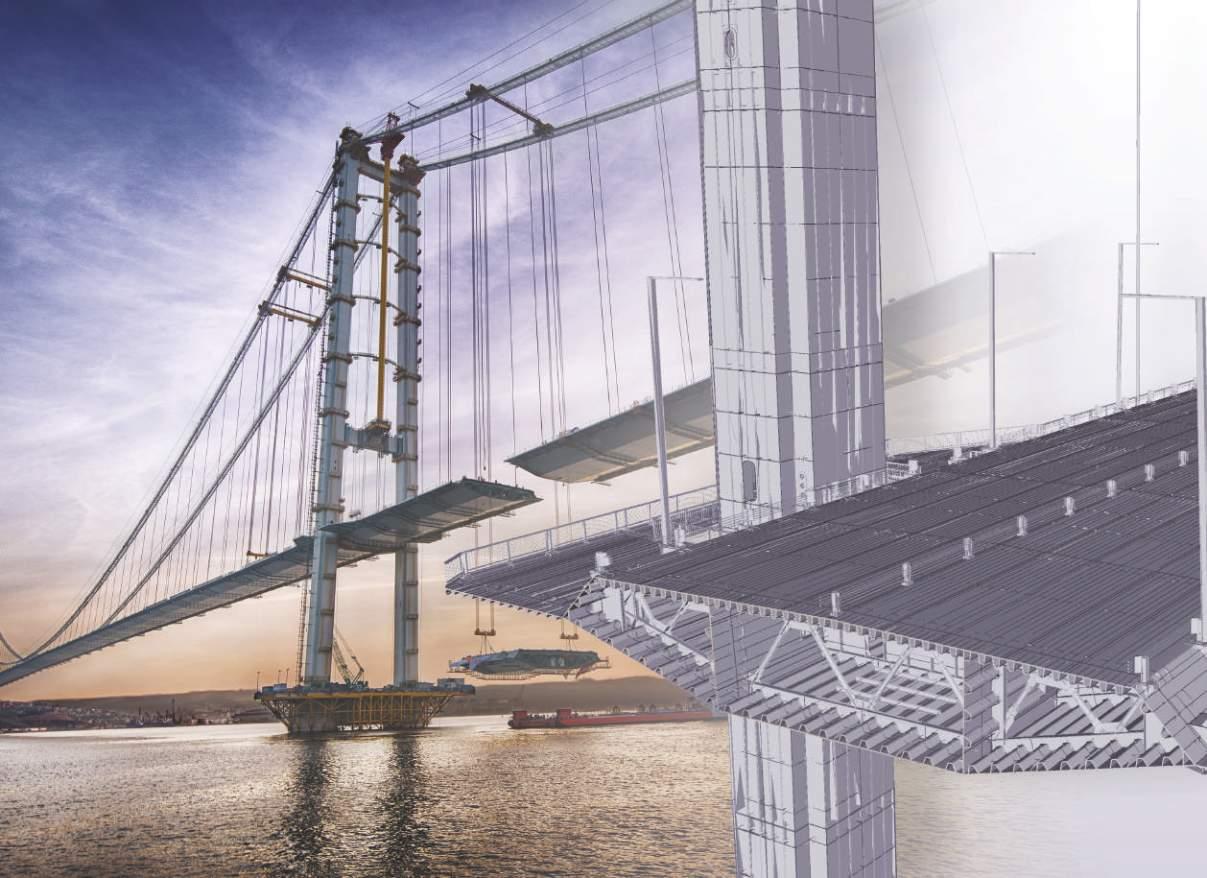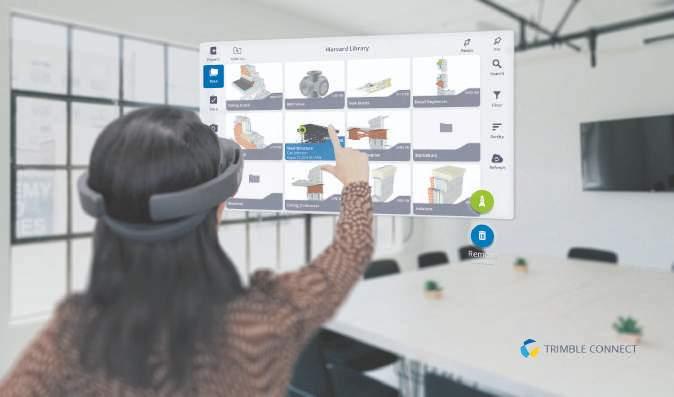
8 minute read
Trimble’s digital innovations in construction technology evolve around constructability

Advertisement
Trimble is a California based service technology company and is a mix of hardware, software and mobility technologies streamlines communication and collaboration throughout the construction lifecycle, from planning, design and site preparation through to the finished project. Paul Wallett, Regional Director, Middle East and India, Trimble Solutions, talks about the role of digitisation in the Indian construction sector.
How is the construction sector coping with current challenges in Indian economy? After witnessing a phenomenal growth of over 100 per cent during the last fiscal, the construction sector has witnessed a continuous downward spiral. Not just this, the turmoil tremors created multiplier impact across sectors including steel, cement, power, petroleum, aluminum, IT and ports, besides badly bruising the Indian economy.
Despite the ongoing challenges, the government has initiated innumerable initiatives to lift the sector from its current dormant conditions. The measures include authorising the Indian Infrastructure Finance Company Limited (IIFCL) to raise `100 billion by issuing tax free bonds to make highways and port projects, liberalisation of the external commercial borrowing (ECBs) policy, revision in the cap for home loans to `2 million from `0.5 million through inclusion in the priority sector, increase in foreign institutional investors limit in rupee denominated corporate bonds from $6 billion to $15 billion exemption of countervailing duty on cement, etc.
To resist events like present global meltdown, the industry has to look within to develop its competitiveness across segments through enhancing their capabilities in R&D to leverage innovation through indigenous capability and expertise.
What kind of new inventions and techniques can we see in the upcoming year? This year has been a breakthrough year in terms of digitisation of the Indian construction industry. With Prime Minister Narendra Modi declaring 2019-2020 as the year of Construction Technology, there is going to be a push from the government
towards the large-scale adoption of cutting-edge software technology for execution of commercial real estate as well as infrastructure projects.
With further innovation and growth of AI and ML, software such as Microsoft HoloLens is now set to reshape the part of the construction continuum that deals with the conversion of building models into actual buildings. Furthermore, tools like Trimble SketchUp Viewer for HoloLens, add computer-generated surfaces, graphics, and objects into the real environment around a user, bringing 3D models to life and putting information in the user’s hands without the need to change or adjust the data format. Using HoloLens, a 3D BIM model can be projected to guide construction teams on-site, and laterby facility management teams when evaluating required changes or maintenance work. While 3D BIM (design BIM) has been in use for several years now,




there is a growing demand for Constructible BIM, which is much more evolved way to allow the construction industry to be more efficient and productive. Trimble has also added the fourth and fifth dimensions of time and cost to the conundrum, which allows contractors and developers to manage their businesses more efficiently than before.

Trimble’s digital innovations in construction technology revolve around constructability. We have developed a unique lifecycle approach to ensure our customers can successfully realise the full benefits of BIM and automation by emphasizing on the 3Cs of construction: connected, contentenabled and constructible.
Modern collaboration tools like Tekla Model Sharing and Trimble Connect allow streamlined flow of information between different stakeholders. These tools can take in building information models with construction schedule and stream this information to remote devices, like smart phones, leading to significant gains in speed of execution.
Internet of things (IoT) is another disruptive technology that is helping speed up the construction process and reduces the wastage of resources on site. Internet-connected sensors embedded in equipment, materials or even helmets worn by workers can transmit real-time data; allowing project managers and supervisors to monitor critical performance parameters on an ongoing basis. This optimises site operations for unprecedented productivity and efficiency. Use of robots in the construction industry is no longer a visual revelation alone; the industry is facing an ever-increasing pressure to construct quickly and in a reliable way, and this is where robots are being found quite useful.
How much can fast tracking of projects and relaxation in bureaucracy further boost construction sector? As a standard practice world over, most of the infrastructure projects are delayed primarily due to regulatory approvals, issues on land acquisition, shortage of skilled resources, ineffective dispute resolution mechanism, and geological challenges. However, if one comprehends these issues proactively, the project leader can plan more effectively and ensure that the project is efficiently managed. It has become imperative to recognise the need for heavy investment in project pre-planning, to strengthen processes and capabilities in terms of reforming procurement and strengthening contract management, bringing in lean construction methodologies for improving productivity, incorporating a culture of risk management, augmenting organisational skill-sets, and deepening stakeholder management for land acquisition and regulatory approvals related challenges.
How can the new metro/monorail projects help the sector in the next year? India is emerging as a fast growing market for urban rail systems. Currently, 10 cities have an operational urban rail network spanning 536 km. The network has grown significantly over the past 12-13 years, up from about 90 km in 2006. With the Metro Rail Policy 2017 in place, several cities are ready to roll out work to develop their respective urban transit systems. In the last five years, 13 new metro projects with a total length of about 248 km have been approved for implementation. Further, about 750 km of metro rail network and 373 km of rapid rail transit network is under planning in various cities.
While metro will continue to be the dominant mode, new modes such as, rapid rail and light rail are also gaining traction. State-of-the-art rolling stock and advanced signaling and telecommunication systems are expected to be deployed as part of these projects.
How can the sector play a positive role in tackling pollution? It’s no secret that the construction sector has a significant impact on the environment. According to some studies, construction is responsible for up to 50 per cent of climate change, 40 per cent of energy usage globally, and 50 per cent of landfill waste, not to mention air, water, and noise pollution and destruction of natural habitats. Fortunately for the construction industry, the same changes that will protect the environment from the harmful impacts of construction can also improve the quality of construction products and boost profits for construction firms. This mutually beneficial relationship plays out across all phases of construction, from the initial design to the building process to long-term building operations.
With IoT and advanced software solutions like Constructible BIM, industry professionals can now use technology right through the lifecycle of construction, build structures that reduce the emissions and thus make earth a better and more sustainable place. Technology works actively to reduce wastage of time, as well as people and money resources.
What kind of forecast is the sector predicting for next year in terms of investments? The construction sector currently has a share of eight per cent in the gross value added at the current prices and has degrown from 9.6 per cent in Q1 FY19 to 5.7 per cent in Q1 FY20 . ‘Construction in India – Key Trends and Opportunities to 2023’ reveals that India’s construction industry, which registered an output growth of 8.8 per cent, up from 1.9 per cent in 2017, is further expected to grow at a compounded annual average rate of 6.44 per cent to US$690.9 billion in 2023. The construction sector is on the path to recovery.
Empowering &Sustainability Green Buildings Empowering &Sustainability Green Buildings


BUILD GREEN, LIVE GREEN
For a Better Tomorrow BUILD GREEN, LIVE GREEN
For a Better Tomorrow
INDUSTRIES WE SERVE INDUSTRIES WE SERVE
Hospitality Hospitality
R
Smart City Smart City
IndustrialIT Park IndustrialIT Park Empowering &Sustainability Green Buildings

Government Commercial Government Commercial
OUR 360 SUSTAINABILITY SOLUTIONS OUR 360 SUSTAINABILITY SOLUTIONS BUILD GREEN, LIVE GREEN
For a Better Tomorrow
Ÿ Climate Design Analysis Ÿ Energy modeling & Simulation Ÿ Energy Audits Ÿ Building commissioning Ÿ Solar System Integrator Responsive Ÿ Sustainability Consultancy Ÿ MOEF & ECBC Compliance Ÿ Green Construction Management Ÿ ECO Friendly Waste Water Treatment Solutions Ÿ CSR | Green Education & Training Programs NEED LEED CERTIFICATION? NEED GRIHA CERTIFICATION? NEED IGBC CERTIFICATION? NEED ECBC COMPLIANCE? Ÿ Climate Design Analysis Ÿ Energy modeling & Simulation Ÿ Energy Audits Ÿ Building commissioning Ÿ Solar System Integrator Responsive Ÿ Sustainability Consultancy Ÿ MOEF & ECBC Compliance Ÿ Green Construction Management Ÿ ECO Friendly Waste Water Treatment Solutions Ÿ CSR | Green Education & Training Programs NEED LEED CERTIFICATION? NEED GRIHA CERTIFICATION? NEED IGBC CERTIFICATION? NEED ECBC COMPLIANCE? W ish You A V ery HAP PY NEW Y EAR Hospitality Education Residential Healthcare Smart City INDUSTRIES WE SERVE
IT Park Industrial









